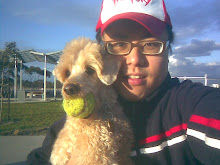This week's lecture on lighting was very, eh, enlightening. I got in slightly late, but I didn't miss the good bits.
I found the number of different lights rather daunting. Firstly, I've always known the two more commonly known lights - hard and soft. Now, there are two more. Key and Fill. But what I had thought was hard and soft light was also, wrong. Before, I thought hard light was bright light and soft light was low level of lights. Boy was I wrong. Also, what I thought was soft and hard light looked was wrong too.
"Lighting can emphasize important details or hide them. It can flatter a subject by bringing out positive attributes, and it can de-emphasize or hide less attractive attributes. Lighting can even impart a sinister and hostile look. It all depends on how you choose to use the concepts we'll be covering in the next few modules."
Take this as an example:
This is really, soft light.
This would have been my choice for soft lights as it has shadows cast on it and the light was at an angle, probably several feet away.
This is really, hard light.
Yikes, I really don't know anything about lights!
Hard Light
"Hard light casts a sharp, clearly defined shadow. When hard light is used to illuminate a face, imperfections in the skin stand out. The result is less than flattering. But in other applications, such as bringing out the texture in leather, or the engraving on a piece of jewelry, this can be an advantage."
"Soft light sources are used in production to create a broad, even area of light. In the field, videographers often rely on umbrella reflectors (on the right, below) to create a soft lighting effect. As you can see, this is simply a light bounced off the inside of a silver or white, umbrella-like reflector. The illustration below on the left shows a much heavier soft light that is commonly hung from the grid in studios."
Key Light
In the picture on the left, key light is placed at an angle of between 30 and 45 degrees from either the left or the right of the camera. Forty-five degrees off to one side is best because, among other things, it brings out more texture and form (dimension) in the subject. For the sake of consistency, the 45-degree angle will be used throughout this discussion.
Fill Light
I have never heard of fill lighting until the lecture this week. Hell sitting at the lecture, I didn't even think I understood what he said! How can a light soften the harshness of another light? It doesn't make any sense. Isn't fill light the same as soft light then?
Ideally, the fill light should be about 90 degrees away from the key light. This means that if you draw lines from the key to the subject and then to the fill light, you'll create a right angle. Although the fill can be positioned at any point from right beside the camera to 45 degrees away, it's safest to place the fill 45 degrees from the camera.
By lighting a full 90 degree area, an important margin of safety is created in case subjects unexpectedly move and camera angles have to be changed during the production. Having to stop a production to change the position of lights can represent a time-consuming and costly delay — not to mention, making you a bit unpopular with the cast and crew.
This is a good website for TV production notes. I sourced all the information from here.

No comments:
Post a Comment